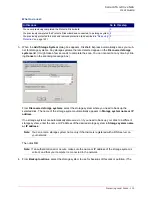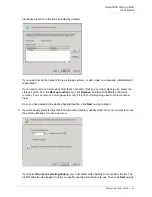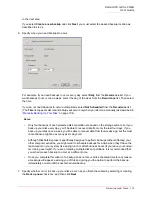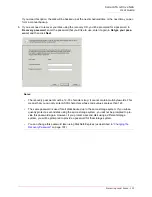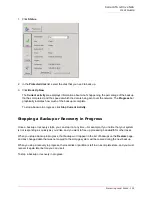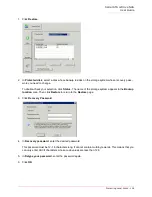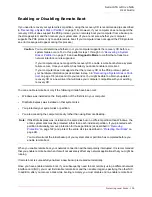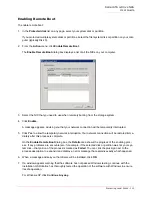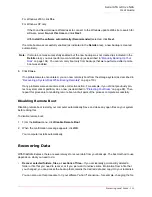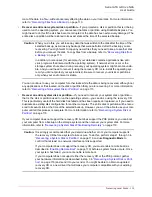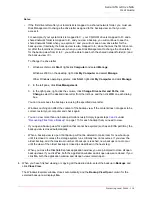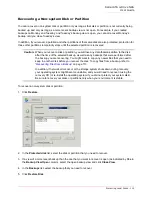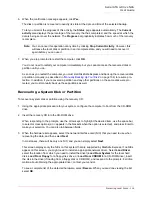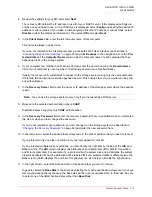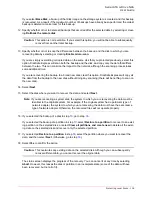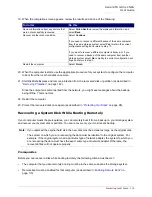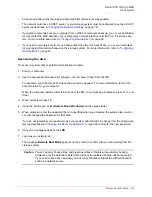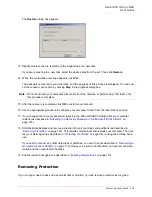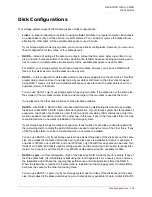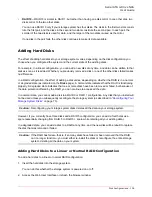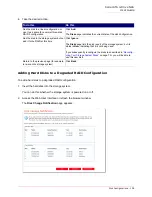
Serial ATA 4-Drive NAS
User Guide
Protecting Local Disks - 114
4. When you have finished viewing or copying all the desired data, select the backup in
Backups
and
click
Close View
.
The Windows Explorer window closes automatically, and the
Backup View Open
column for the
selected backup now displays
No
.
Notes:
•
If the first drive letter after your local disks is mapped to a shared network folder, you must use
Disk Management to change the drive letter assigned to the backup view so that you can
access it.
For example, if your system disk is mapped to C:, your CD-ROM drive is mapped to D:, and a
shared network folder is mapped to E:, and you view a backup, you will continue to see the
shared network folder when you explore E:, and you will not see a new drive letter for the
backup view. (Internally, the backup view is also mapped to E:, since that was the first drive let-
ter after the local disks.) However, when you use Disk Management to change the drive letter
for the backup view from E: to F:, you will be able to see both the shared network folder (E:) and
the backup view (F:).
To change the drive letter,
1. Windows Vista: click
Start
, right-click
Computer
and select
Manage
.
Windows 2000: on the desktop, right-click
My Computer
and select
Manage
.
Other Windows operating systems: click
Start
, right-click
My Computer
and click
Manage
.
2. In the left pane, click
Disk Management
.
3. In the right pane, right-click the volume, click
Change Drive Letter and Paths
, click
Change
, select the desired drive letter from the list box, and then click
OK
on each dialog
box.
You can now access the backup view using the specified drive letter.
•
Windows caching can affect the content of the backup view. If the content does not appear to be
correct, restart your computer and check again.
•
You can view more than one backup simultaneously. Simply repeat steps
3
and 4
under
“Recovering Files from a Backup”
on page 113 for each backup that you need to view.
•
If you open a backup view for a partition that cannot be explored (such as an EISA partition), the
backup view is closed automatically.
•
When a backup view is open, that backup will not be deleted to make room for new backups
until it is closed or unless the storage system runs critically low on resources. If you view the
oldest backup, and the maximum number of backups is reached, new backups cannot occur
until the view of the oldest backup is closed (as described in the next step).
•
When you close the DiskSafe Express application window, you are prompted to close all open
backup views. If you click
Yes
, both the application window and all open views are closed. If you
click
No
, both the application window and all open views remain open.
Содержание USR8700
Страница 1: ...Serial ATA 4 Drive NAS User Guide R46 1702 00 rev 0 8 04 07 ...
Страница 6: ...Serial ATA 4 Drive NAS User Guide vi ...
Страница 8: ...Serial ATA 4 Drive NAS User Guide Safety Instructions 8 ...
Страница 35: ...Serial ATA 4 Drive NAS User Guide Getting Started 33 Windows Mac OS X user CIFS Linux Other Mac user NFS ...
Страница 46: ...Serial ATA 4 Drive NAS User Guide Getting Started 44 ...
Страница 86: ...Serial ATA 4 Drive NAS User Guide Managing Your Storage System 84 ...
Страница 126: ...Serial ATA 4 Drive NAS User Guide Protecting Local Disks 124 ...
Страница 136: ...Serial ATA 4 Drive NAS User Guide Disk Configurations 134 ...

